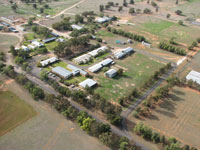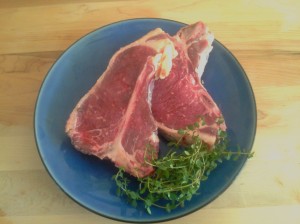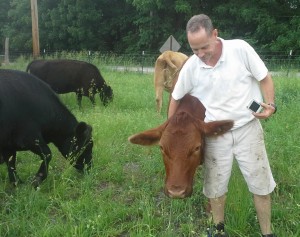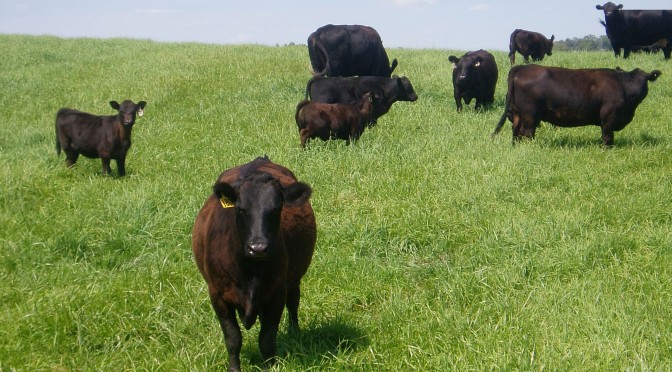Quality Grass Fed Beef
Producing Quality Grass Fed Beef starts with our philosophy. Our tag line, “Sustainable Nutrition” describes this. Our quality assurance and quality control begins with the best possible genetics. It is a small herd of Aberdeen (formerly Lowline) Angus that produces our delicious aged beef. A truly superior product in terms of the following:
Genetics
The research that led to the Aberdeen Angus breed began at the Trangie Research Center in Australia in 1929. From 1929-1964

Trangie acquired the best Aberdeen Angus from Canada, the USA, Scotland and New South Wales. The purpose was to isolate superior genetic material. Aberdeens are the direct descendants of the best prize-winning Angus blood-lines on the planet.
After 1974, the herd remained closed for 19 years, producing a new breed of cattle. Aberdeen or Lowline Angus.
Aberdeens were the result of over 64 years of effort. This included selections for superior genetics, protein conversion efficiency and meat quality. The research culminated on August 8, 1992. That day seven Australian cattlemen met beneath a gum tree at the Trangie Center auction site, they bought the herd and formed the Australian Lowline Cattle Association. Pippa, the first fullblood heifer in America, arrived in North Dakota in July of 1996.
Aberdeen Beef Quality
Aberdeens are the direct descendants of prize-winning Angus blood-lines. This has produced an animal that is smaller in stature and carries prime beef qualities without having to be force fed corn in a confined feeding operation.

Aberdeens have superior traits with 30% larger ribeye area per hundredweight than any other breed and they possess excellent marbling characteristics that are exhibited on grass alone. Aberdeen beef is superior in quality, with excellent taste, texture and tenderness. Our beef is naturally marbled without being excessive.
Smaller cattle have finer grained beef and finer grained beef is the most tender. This is due to the shorter cell muscular structure. They are, in general, 30% smaller than traditional breeds. Quality grass fed beef begins with genetics and ends with care.
Full Sircle Husbandry

Producing nutritious quality grass fed beef starts with excellent genetics. Then it is enhanced by management and careful attention to diet. To bring Aberdeen genetic qualities to their full potential we begin with the environment. That means we closely monitor soil conditions to provide the best quality grasses and legumes. Bromegrass, red clover, timothy, white clover, orchard grass and the occasional nettle balance the nutritional requirements for protein, vitamins and dry matter. All natural supplements, vitamins, minerals and the availability of clean drinking water is another key to providing the most nutritious beef possible. Our cattle are what they eat, and so are you.
The Aberdeen herd always has access to grass, hay and the natural environment as the health and happiness of the animal is important for the final product. Our cattle live in a stress free environment as this has a direct correlation to the quality of the meat produced.
As such we rotate the pastures regularly and we engage in low stress stock handling techniques. Our beef is hormone and antibiotic free. We only administer medicines in order to save an animal from sickness, but they rarely ever get sick! We believe that due to their care in terms of diet and environment,
Sustainable Nutrition
Aberdeens are incredibly efficient converters of grass to protein. Some Aberdeens were found to be up to 100% more efficient on grass than other breeds.

According to David Pimentel, a Cornell ecologist who specializes in agriculture and energy, the corn we feed our feedlot cattle accounts for a staggering amount of fossil fuel energy. Growing the corn used to feed livestock takes vast quantities of chemical fertilizer, which in turn takes vast quantities of oil. Because of this dependence on petroleum, Pimentel says, a typical steer will in effect consume 284 gallons of oil in his lifetime.
Comments Michael Pollan on confined animal feeding operations:
“We have succeeded in industrializing the beef calf, transforming what was once a solar-powered ruminant into the very last thing we need: another fossil-fuel machine.”
Grassfed beef has another environmental advantage — it is far less polluting. The animals’ wastes drop onto the land, becoming nutrients for the next cycle of crops. In feedlots and other forms of factory farming, however, the animals’ wastes build up in enormous quantities, becoming a staggering source of water and air pollution.
Nutrients
Aberdeens possess the ability to produce nutrient dense protein and intramuscular fats called marbling on grass alone.

Beef that is well marbled indicates that ratio between mono-unsaturated and saturated fat ratio is higher. Fifty percent of all marbling is made up of oleic acid (mono-unsaturated), while a relatively small proportion is saturated fat.
Another benefit from marbling is derived from a particular component of the omega-6 polyunsaturated fatty acids, called conjugated linoleic acid (CLA). CLA has shown to have anti-carcinogenic (cancer forming) effects as well as being anti-inflammatory. It has a whole raft of health benefits such as reducing heart disease, diabetes and asthma to name a few.
Grass-fed cattle that are well marbled have the highest amount of CLA per gram due to higher linoleic acid levels. The concentration of CLA in fat is highest in pasture rather than grain fed cattle.


One thought on “Quality Assurance”
Comments are closed.